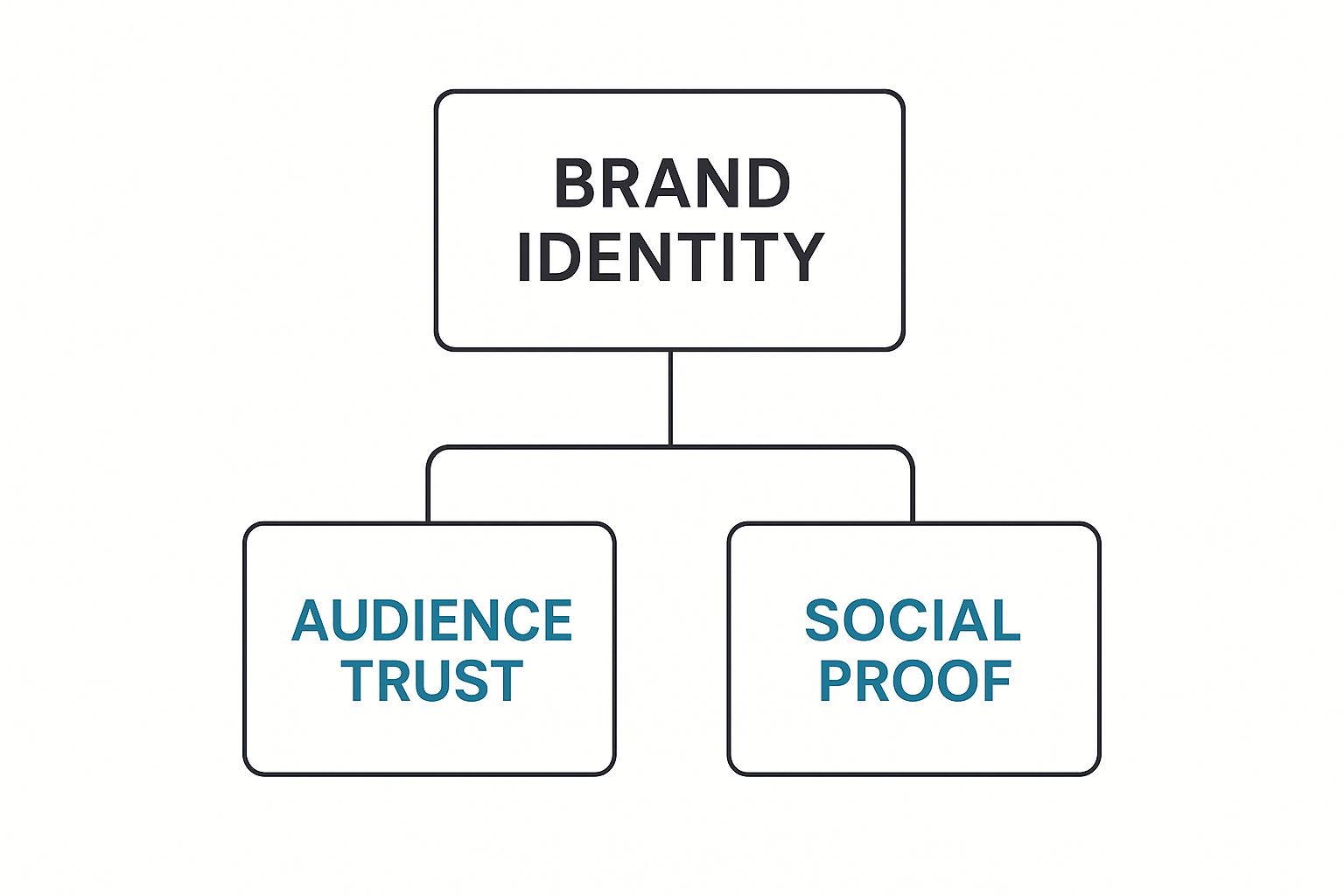
As a founder, you learn one thing fast: your brand isn't what you say it is. It's what everyone else says it is, and they're saying it on social media. This is the new town square, and social media reputation management is the non-negotiable work of listening to, engaging with, and guiding those conversations to build trust.
Forget thinking of it as damage control. This is a growth engine.
This guide is our founder-to-founder playbook. No generic advice. We’re opening up and sharing the exact systems, filters, and templates we use inside BillyBuzz to manage our own reputation. We’ll show you how to:
- Build a listening engine that catches every conversation that matters.
- Respond with a plan that turns critics into fans.
- Proactively shape your narrative to generate authentic social proof.
Let's get straight to it.
Building Your Brand's Listening Engine
You can't manage a reputation you can't hear. We don't passively wait for someone to tag us. We've built what we call a "Listening Engine"—our digital eyes and ears, running 24/7.
This isn't generic brand monitoring. It's a precise, founder-led system designed to catch every important conversation, good or bad, before it snowballs. Forget just tracking your brand name; you have to go deeper to find the real signals.
Setting Up Your Keyword Alerts
The heart of our Listening Engine is a structured set of keyword alerts. Our workhorse is Brand24 for its powerful filtering and Slack integration. This setup ensures we get real-time pings for the conversations that actually matter.
Here’s the exact alert structure we use at BillyBuzz. Copy it.
- Direct Brand Mentions: Track "BillyBuzz," but also common typos like "Billy Buzz" or "Billybuzz." It's amazing how often people get it wrong.
- Problem-Based Keywords: This is where you find the gold. We monitor
"[Our Brand] + problem","[Our Brand] + issue", or"[Our Brand] + not working". These are smoke signals. - Purchase Intent Keywords: We hunt for people ready to buy. Alerts for
"alternative to [Competitor Name]"or"best tool for [our core feature]"are high-priority signals. - Competitor Mentions: We watch our main competitors. It's not about being petty—it's about finding their customers' biggest complaints and spotting opportunities where our product is a better fit.
Getting this right is a game-changer. For a step-by-step walkthrough, check out our guide to setting up real-time social media alerts.
Monitoring Beyond the Obvious Platforms
X and LinkedIn are crucial, but the most honest conversations often happen in niche communities. For us, Reddit is a treasure trove of unfiltered feedback. We don't cast a wide net; we zero in on specific subreddits where our target audience—founders and marketers—hangs out.
Our primary targets inside BillyBuzz are:
- r/startups: A hub for founders talking challenges, tools, and growth.
- r/SaaS: The go-to for software businesses, perfect for feature feedback.
- r/marketing: A broader community where professionals discuss tactics.
By focusing here, our alerts become far more relevant. We're not just finding keywords; we're finding them in the rooms where the right people are talking.
Using Tools to Filter and Act
A good Listening Engine produces a ton of data. The final step is turning that flood into something actionable. A dashboard, like this example from Brand24, is key to organizing mentions, sentiment, and reach into a clear overview.
This visual breakdown lets us see sentiment trends at a glance. Are mentions getting more positive or negative? It also helps us pinpoint influential comments that need an immediate, personal response. This systematic approach to listening isn't just about protecting your brand; it's about growing it.
How to Respond: The BillyBuzz Template Matrix

Knowing a conversation is happening is just step one. The real test is knowing exactly what to say. A generic, robotic response is as damaging as silence. As a founder, every reply carries weight.
We don't leave this to chance. We’ve built a simple but powerful framework that guides every interaction, ensuring we always sound human, helpful, and in control.
The A.E.S.F. Response Framework
You don't need a complicated flowchart. Every solid response, for a glowing review or a scathing critique, should follow our internal A.E.S.F. framework: Acknowledge, Empathize, Solve, and Follow-up.
Acknowledge what was said. Empathize with how they feel. Solve the problem. Follow-up to ensure it's resolved. This is our secret weapon for turning critics into fans.
BillyBuzz Response Template Matrix
To make this dead simple to apply, here are our core response templates. Think of this as a quick-reference guide for your team to ensure every reply is on-brand and effective.
| Scenario Type | Key Objective | Core Message Template | Example Snippet |
|---|---|---|---|
| Negative Feedback | De-escalate & Solve | Acknowledge pain, empathize, offer a direct solution path (DM, email), and promise a follow-up. | "I'm so sorry you ran into this. That's not the experience we want for you. Can you DM us your ticket number so I can personally look into it?" |
| Positive Shout-Out | Amplify & Engage | Thank them specifically, add a small piece of value (like a fun fact), and encourage further interaction. | "This is fantastic to hear! We're thrilled you love the new dashboard. Thanks for being such an awesome member of our community!" |
| Neutral/Skeptical | Educate & Reassure | Validate the question, explain the "why" behind a feature or decision, and offer more resources. | "That's a great question. We chose this approach to improve [X benefit]. We have a blog post that goes deeper if you're curious!" |
| Feature Request | Acknowledge & Inform | Thank them for the idea, explain how you handle feedback, and direct them to the proper channel (e.g., roadmap). | "Love this idea! We track all feature requests on our feedback board here: [link]. We'll be sure to add your vote." |
Using a structured yet flexible framework like this empowers your team to handle conversations with confidence. It ensures consistency while leaving room for personalization—the key to building a brand people connect with. For a deeper dive, check out our checklist for effective social media engagement.
Proactively Shaping Your Brand Narrative

Social media reputation management isn't just about playing defense. A strong defense is built on a powerful offense. Instead of waiting for conversations to happen to you, get ahead of them. Build a narrative so positive that it becomes the dominant story people find.
This isn't a side project; it's a core part of our growth engine at BillyBuzz. This isn't about faking positivity—it’s about systematically building a fortress of trust.
Turning Happy Customers into Vocal Advocates
Your most satisfied users are your greatest marketing asset, but they're busy. They aren't likely to sing your praises without a nudge. Your job is to make it incredibly easy for them. We have a simple, two-step process:
First, we use our listening tools to flag super positive mentions—phrases like "love this feature" or "saved me so much time." Second, our community manager reaches out personally. No bots.
Here’s the template we use:
"Hey [Name], just saw your comment about [specific feature] and it absolutely made our day! So glad to hear it's helping you. If you ever have a spare minute, leaving a quick review on [Platform Link] would mean the world to our small team. No pressure at all, but we'd be hugely grateful!"
It's human. It acknowledges their specific feedback and makes them feel seen, dramatically increasing the odds they'll leave a review.
Building Authority Through Founder-Led Content
Social proof isn't just customer reviews. As a founder, your voice is a powerful tool. We've found that creating genuinely useful content on LinkedIn and X is a cornerstone of our strategy.
This isn’t about generic company updates. It's about sharing the "why" behind your decisions and offering real advice.
- On LinkedIn: We share behind-the-scenes looks at how we build products and discuss the real challenges facing other SaaS founders.
- On X: The vibe is more rapid-fire. We engage in quick discussions, share tips, and participate in industry debates.
This strategy positions the founder as a trusted expert. When people trust you, they are far more likely to trust your brand. This proactive approach is critical, especially when you consider that a single negative event can spiral into a full-blown crisis. Understanding social media crisis management is a key part of any proactive reputation strategy.
Measuring the Metrics That Actually Matter
You can't fix what you can't see. Getting caught up in vanity metrics like follower counts or likes is a rookie mistake. To get a real pulse on how people see your brand, you have to track KPIs that reflect perception and feeling.
The Three Pillars of Reputation Tracking
I've learned that you can get a clear picture of your brand's health by focusing on just three core metrics.
- Sentiment Score: This is your north star. It's the ratio of positive to negative mentions. A rising score is a clear sign you're building goodwill.
- Share of Voice (SoV): This is all about context. It tells you how much of the conversation in your industry you own compared to your competitors. If there are 1,000 total mentions for your niche and your brand gets 300, your SoV is 30%.
- Average Response Time: Speed is everything. Tracking how quickly your team replies to comments—especially negative ones—is critical. A fast response shows you're listening and can de-escalate a potential crisis.
Your Monthly Reputation Report Framework
As a founder, you don't have time for a 20-page report. You need a simple, one-page dashboard you can digest in five minutes.
Here’s a straightforward framework for a monthly check-in:
- Mention Volume & Trend: How many people talked about us this month? Is that number trending up or down?
- Key Metric Dashboard: Put your Sentiment Score, SoV, and Average Response Time front and center. Use simple green/red arrows for improving/declining.
- Recurring Feedback Themes: What are the top 3-5 things people are saying over and over? Praise for a new feature? A complaint about a bug? This is priceless feedback.
- Platform Ratings: What are your current average star ratings on key review sites? This tells you where to focus customer service.
Tracking these core metrics transforms reputation management from a vague concept into a measurable part of your business. It gives you clear goals and shows you exactly what's working.
Modern customers build trust on authentic feedback. 85% of consumers trust online reviews as much as personal recommendations. You can explore more about these reputation statistics to see just how critical this has become. To automate this, exploring the best social media analytics tools is a smart move. They make this kind of reporting manageable.
Founder FAQs on Reputation Management

We get the same questions from fellow founders all the time. Let's cut the fluff. Here are direct answers.
How Much Time Should a Startup Founder Dedicate to This?
30-60 minutes a day. The key is consistency, not cramming.
Use the "Listening Engine" alerts we talked about. The most important conversations come to you. Block out time each morning to review and respond. When a founder personally responds, it sends a powerful message. The goal isn't to live on social media; it’s to build a system so nothing important slips through.
Should I Delete Negative Comments on My Social Pages?
Almost never.
Deleting criticism is one of the fastest ways to burn trust. It looks like you're hiding something and almost always backfires.
Instead, respond publicly. A well-handled negative comment is more valuable than ten positive ones because it’s a public demonstration of your company's character. You’re showing everyone you’re transparent, accountable, and committed to fixing problems.
The only time you should delete a comment is if it's clear spam, contains hate speech, or exposes private information. Legitimate criticism? Tackle it head-on, every time.
What Is the Best First Tool for a Startup on a Budget?
Start with what's free. Don't get suckered into a pricey tool before you have a process.
Google Alerts and the free version of TweetDeck are surprisingly effective and cost nothing. Set them up to track your brand name, your personal name, and a top competitor.
Once you’re getting real value and hitting a wall, then upgrade. A platform like Brand24 or Mention is a great next step, usually for under $100 a month. They give you deeper tracking and that all-important sentiment analysis. Prove the process first, then pay for a tool to solve a specific problem.
Effective social media reputation management is a non-negotiable part of growing a business. At BillyBuzz, we built our platform to give founders and marketing teams the tools to discover and engage new customers on Reddit, turning conversations into conversions. Stop missing out on hidden leads and start building your brand where it matters most. Discover how BillyBuzz can help you grow.
